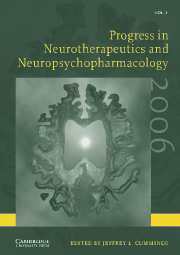Book contents
- Frontmatter
- Contents
- Preface
- Contributors
- Introduction to neurotherapeutics and neuropsychopharmacology
- Rivastigmine in the treatment of dementia associated with Parkinson's disease: a randomized, double-blind, placebo-controlled study
- Modafinil for the treatment of fatigue in multiple sclerosis
- Radiotherapy with concurrent and adjuvant temozolomide: a new standard of care for glioblastoma multiforme
- Treating migraine attacks ASAP: concept and methodological issues
- Early phase trials of minocycline in amyotrophic lateral sclerosis
- Creatine as a potential treatment for amyotrophic lateral sclerosis
- AVP-923 as a novel treatment for pseudobulbar affect in ALS
- Liquid fluoxetine versus placebo for repetitive behaviors in childhood autism
- Testing multiple novel mechanisms for treating schizophrenia in a single trial
- Selegiline in the treatment of negative symptoms of schizophrenia
- Analysis of the cognitive enhancing effects of modafinil in schizophrenia
- Efficacy and tolerability of ziprasidone and olanzapine in acutely ill inpatients with schizophrenia or schizoaffective disorder: results of a double-blind, six-week study, with a six-month, double-blind, continuation phase
- Subject index
- Author index
Creatine as a potential treatment for amyotrophic lateral sclerosis
Published online by Cambridge University Press: 22 March 2010
- Frontmatter
- Contents
- Preface
- Contributors
- Introduction to neurotherapeutics and neuropsychopharmacology
- Rivastigmine in the treatment of dementia associated with Parkinson's disease: a randomized, double-blind, placebo-controlled study
- Modafinil for the treatment of fatigue in multiple sclerosis
- Radiotherapy with concurrent and adjuvant temozolomide: a new standard of care for glioblastoma multiforme
- Treating migraine attacks ASAP: concept and methodological issues
- Early phase trials of minocycline in amyotrophic lateral sclerosis
- Creatine as a potential treatment for amyotrophic lateral sclerosis
- AVP-923 as a novel treatment for pseudobulbar affect in ALS
- Liquid fluoxetine versus placebo for repetitive behaviors in childhood autism
- Testing multiple novel mechanisms for treating schizophrenia in a single trial
- Selegiline in the treatment of negative symptoms of schizophrenia
- Analysis of the cognitive enhancing effects of modafinil in schizophrenia
- Efficacy and tolerability of ziprasidone and olanzapine in acutely ill inpatients with schizophrenia or schizoaffective disorder: results of a double-blind, six-week study, with a six-month, double-blind, continuation phase
- Subject index
- Author index
Summary
Key words: Creatine; amyotrophic lateral sclerosis; clinical trials; neurotherapeutics; transgenic mouse models; ALS functional rating scale.
Introduction
Amyotrophic lateral sclerosis (ALS) is a rare degenerative disorder of large motor neurons that results in progressive wasting and paralysis of voluntary muscles of the extremities, bulbar regions and respiratory apparatus (Rowland, 1994; Mulder, 1982). The incidence of ALS is currently approximately 2/100 000/year (Chio & Silani, 2001; Haverkamp et al., 1995) with a prevalence of approximately 5/100 000. The lifetime ALS risk is 1 in 600 to 1 in 1000. Fifty percent of ALS cases die within 3 years of onset of symptoms and 90% die within 5 years (Shefner, 1996; Kurtzke & Kurland, 1989). The median age of onset is 55 years. In sporadic disease, males are at slightly greater risk, while the male/female ratio is 1 : 1 in most cases of familial disease. Ten Percent of patients have a history of the disease in first degree relatives; about 20% of these patients have a mutation in the gene encoding cytosolic copper–zinc superoxide dismutase (SOD1) have been robustly identified as causing typical familial ALS (fALS) (Rosen et al., 1993).
Patients with ALS typically present with focal weakness of an arm, a leg, or of facial and bulbar muscles. The weakness typically progresses regionally and ultimately involves all muscles of voluntary movement. Both lower motor neurons (spinal) and upper (cortical) motor neurons are involved, so that patients display signs of atrophy, fasciculations, cramps and weakness in combination with spasticity, increased stretch reflexes and incoordination. Although there is sometimes pathologic evidence of sensory neuron loss, clinically, sensory signs are sparse or absent (Shefner et al., 1991).
- Type
- Chapter
- Information
- Publisher: Cambridge University PressPrint publication year: 2006



